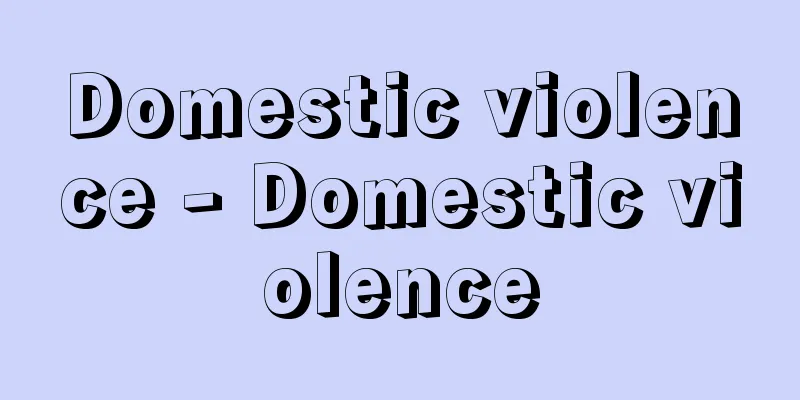Domestic violence - Domestic violence

|
In a broad sense, it refers to violence between family members such as husbands, wives, children, grandparents, and the resulting destruction and damage of property and buildings, as well as abusive language. In a narrow sense, it refers to violence, harm, abuse, abusive language, and abusive language by children and grandchildren directed at parents, and in rare cases grandparents, as well as the destruction and damage of property and buildings in the home. In general, it is often used in the narrow sense. Juveniles' antisocial acts of violence and damage to property both inside and outside the home have existed since before World War II, but domestic violence, in which so-called antisocial children who appear quiet and obedient suddenly become violent toward family members, especially parents, has become prominent in Japan since around 1960 (Showa 35). In terms of development, high school students are the most common, followed by junior high school students, university students, and elementary school students. There are overwhelmingly more boys than girls, with two to three times as many. Domestic violence occurs suddenly due to incidents inside or outside the home, psychological shocks, social stimuli, etc., and then explodes, continues for a long time, and becomes a habit. It is characteristic that the violence is directed only at those within the home, not at people or things outside the home. Moreover, it is overwhelmingly directed at the mother. Domestic violence includes silencing, ignoring, arguing, resisting, defiance, physical violence, harm, verbal abuse, abusive language, damage to property, destruction of buildings, and extortion of money or goods. Domestic violence follows a different course of behavioral expression than other delinquency among juveniles. The first stage is the "good kid" stage, where the child is quiet, easy to maintain, and obedient. The second stage is the "silent" stage, where the child becomes somewhat less talkative, has a stiff expression, and gives simpler responses. They harbor complaints and dissatisfaction. The third stage is the resistance and rebellion stage, where the child verbally expresses complaints and dissatisfaction, resists their parents, and directly rebels. The fourth stage is the coercion and verbal abuse stage, where the child demands money and pressures the purchase of expensive goods, and if this is not met, they move on to violence and destruction. Or they become indulgent in their verbal abuse. The fifth stage is the violent and destructive stage, in which violence and destructive behavior reaches its peak, the child refuses to go to school, becomes dependent on drugs such as narcotics, alcohol, and paint thinner, rejects interpersonal relationships, and develops a chronic reversal of day and night patterns. The causes of domestic violence are generally not simple, unlike physical illnesses. In addition, not only are there multiple overlapping causes, so-called complex causes, but there are also synergistic effects between the causes, and causal relationships are intricately intertwined, making it difficult to identify cause and effect, which makes it difficult to investigate domestic violence and frustrating because it is not possible to clearly indicate how to guide or correct it. The causes, including the current situation of the parents and children, can be summarized into the following six points. (1) Parent-child relationships: There is little separation between parents and children, and children tend to be very dependent on and spoiled by their parents. At the same time, children's rebellion and frustration at parents' excessive interference, overprotection, and excessive expectations form the basis for violence and destructive behavior. Differences in thinking between generations also lead to differences of opinion, and when these become apparent, they trigger children to distrust their parents. (2) Friendships and participation in group activities: The child has no friends or very few friends. Even if they have friends, they are only close friends and one or two friends that the child sees as close friends. Therefore, the child does not easily join group activities. (3) Personality and attitude Before they become violent, they tend to be quiet, timid, submissive, and not very good at speaking. However, deep inside, they have a strong sense of inferiority, timidity, lack of inhibitions, lack of self-esteem, lack of confidence, and weak will, which makes them more likely to become violent. They tend to attack easily when frustrated. Their fathers are calm, kind, and hardworking, while their mothers tend to be competitive, neurotic, and ambitious. (4) Psychopathological tendencies: Some children have psychoses, neuroses, psychosomatic disorders, epilepsy, personality disorders, emotional disorders, or intellectual disabilities. (5) Psychological trauma: Experiences of being abused or coerced by parents, which can lead to feelings of rebellion or revenge, or feelings of frustration due to failure to continue on to higher education, can form the basis for this. (6) Social influences: These include disorder among family members due to the breakdown of the family system, confusion of ethical standards, estrangement from interpersonal relationships in urbanized societies, weakening of emotional communication between family members due to divorce, dual-income households, and job transfers, audiovisual experiences of murder, overstimulation, and violence through the media, and family-wide responses to entrance exam competition and a desire to advance in society. In foreign countries, especially in the United States, there is also violence against parents, which is a type of family violence, and child abuse and domestic violence are also prominent. Also, children's violence against their parents originally stems from antisocial behavior. It is slightly different from domestic violence in Japan, where a quiet child may suddenly become violent towards his mother. Treatment, guidance, correction, and prevention of domestic violence mainly focus on guiding parents to change their attitudes, and the most important thing is to find ways to encourage emotional communication between parents and children. Based on this, counseling, behavioral therapy, drug therapy, hospitalization, etc. are carried out. A firm stance should be taken against any demands for money, and if there are concerns that things may become complicated, it is also necessary to consult with a child consultation center, an education consultation center, or the police. Parents and children should eat meals together as much as possible, have thorough conversations during these meals, and make time to enjoy sports together as parents and children are also effective preventive and response measures. [Harano Hirotaro] "Domestic Violence by Hiroshi Inamura (1980, Shinyosha)" ▽ "Domestic Violence in America by Fumie Kumagai (1983, Science Press)" Source: Shogakukan Encyclopedia Nipponica About Encyclopedia Nipponica Information | Legend |
|
広義には、夫、妻、子供、祖父、祖母など家族間の暴力や、そこからおこる物品・建造物の破壊・破損、暴言などをさす。狭義には、両親、まれには祖父母に向けられる子供や孫の暴力、危害、虐待、暴言、罵詈雑言(ばりぞうごん)および家庭内の物品・建造物などの破壊・破損の行為をいう。一般的には狭義に用いられることが多い。青少年が反社会的行為として、家庭内のみならず家庭外で暴力を振るったり、物を破損する非行は、第二次世界大戦前からあったが、おとなしく従順にみえる、いわゆる非社会的な子供が、突然、家族とくに親に暴力を振るう家庭内暴力は、わが国では、1960年(昭和35)前後から顕著に現れてきた。発達的にみると、高校生がもっとも多く、次に中学生、大学生、小学生の順である。男子が圧倒的に多く、女子の2倍から3倍である。家庭内暴力は家庭内外の事件、心理的衝撃、社会的刺激などによって突然おこり、爆発的に高まり、そのまま長期化、習慣化する。暴力が家庭外の人や物に向かわず、家庭内だけに向けられるのが特徴的である。それも圧倒的に母親に向けられる。 家庭内暴力の内容は、無言、無視、反論、抵抗、反抗、身体的暴力、危害、暴言、罵詈雑言、器物破損、建造物破壊、金銭・物品の強要などである。家庭内暴力は青少年の他の非行とは異なった行動表出経過をたどる。第1期は「良い子供」期である。おとなしい、手のかからない、従順期である。第2期は「だんまり」期である。やや口数が少なくなり、表情が固くなり、返事が単純になる。不平・不満を心にもつ。第3期は抵抗・反抗期である。不平・不満をことばでいい、親に抵抗したり、直接反抗するようになる。第4期は強要・暴言期で、金銭を強要し、高価物品の購入を迫る時期で、これがいれられないと暴力・破壊行為に移行する。あるいは暴言をほしいままにする。第5期が暴力・破壊期で、暴力や破壊行為が頂点に達し、登校拒否がおこり、麻薬、アルコール、シンナーなど薬物への依存、対人関係拒否、昼夜逆転行動が慢性化する。 家庭内暴力の原因は、一般的には身体的疾病と異なって単純ではない。加えて、いくつかの原因が重なる、いわゆる複合原因によるばかりでなく、原因が相互に関係しあう相乗作用があったり、また因果関係が複雑に絡み合ったりして、原因→結果を特定できないところに、家庭内暴力を究明できにくいむずかしさと、その指導・矯正法を明示できないもどかしさがある。親、子供の現状を含めた原因をあげると、次の六つに集約される。 (1)親子関係 親子分離が少なく、子供の親への強い依存心、甘えがあると同時に、親の過干渉・過保護・過剰期待に対する子供の反抗、欲求不満などが暴力・破壊行為の基礎をつくる。世代間の考え方の違いも意見の違いをもたらし、その表面化が子供の親不信の引き金となる。 (2)友人関係・集団活動への参加 友達がないか、ごく少ない。あっても親友と本人がみる一、二の友達だけである。したがって集団活動に気軽に入ろうとしない。 (3)性格・態度 暴力を振るう前は、おとなしく、内気、従順、口下手のほうである。しかし、心のなかには強い劣等感、小心、抑制力欠如、自尊心欠如、自信のなさ、意志の弱さがあって、暴力に出る可能性を潜めている。欲求不満に陥ればすぐ攻撃に出る傾向がある。父親は穏やかで、優しく、仕事熱心であり、母親は負けず嫌い、神経質、上昇志向の傾向がある。 (4)精神病理的傾向 精神病、神経症、心身症、てんかん、性格障害、情動障害、知的障害をもっている子供もいる。 (5)心理的外傷 親に虐待された、強要されたなどの経験をもち、それに対する反抗・復讐(ふくしゅう)、あるいは進学の失敗による挫折(ざせつ)感などが素地をつくる。 (6)社会的影響 家族制度の崩壊による家族メンバー間の無秩序状態、倫理的基準の混乱、都市化社会における対人関係の疎遠、離婚・共働き・転勤などによる家族間の感情的交流の希薄化、マスコミを媒体とする殺傷・過剰刺激・暴力シーンの視聴覚的経験、受験競争や立身出世志向の家庭ぐるみ対応、などがあげられる。 外国とくにアメリカでは、対尊属暴力もあるが、これは家族間暴力の一つであり、同時に児童虐待、夫婦間暴力(ドメスティック・バイオレンス)も顕著である。また、子供の親への暴力は、もともと反社会的行動からおこる。初めおとなしい子供が突然母親に暴力を振るうようになるわが国の家庭内暴力とは若干異なっている。 家庭内暴力の治療、指導、矯正、予防としては、親の態度変容の指導が中心で、親子間の感情的交流を図る手だてがもっともたいせつである。これを基礎に、カウンセリング、行動療法、薬物療法、入院治療などを行う。金銭の強要には断固たる態度をとり、こじれる心配のある場合には、児童相談所・教育相談所・警察署などへ相談することも必要である。普段、親子はできるだけいっしょに食事をする、その際とことん会話を交わす、暇をつくって親子でスポーツを楽しむことなども有効な予防策であり、対応策である。 [原野広太郎] 『稲村博著『家庭内暴力』(1980・新曜社)』▽『熊谷文枝著『アメリカの家庭内暴力』(1983・サイエンス社)』 出典 小学館 日本大百科全書(ニッポニカ)日本大百科全書(ニッポニカ)について 情報 | 凡例 |
<<: Cardiff (English spelling)
>>: Home appliances - Kaitei Denki
Recommend
Yoneyama [town] - Yoneyama
A former town in Tome District, northern Miyagi Pr...
Informal group
It refers to a spontaneous, long-term relationship...
Movement (Korean literature) - gakusho
… [Middle Ages - Goryeo Dynasty] The civil servic...
Steering committee
A standing committee in the Japanese Diet that han...
Taganrog (English spelling)
A city in the Rostov Oblast in southwestern Russia...
Shandong [Province] - Santo
A province in the eastern part of North China. Its...
Goetze, A.
…Hittite was discovered to be a branch of the Ind...
General price level
A comprehensive price level that covers all econom...
Printing machine - Insatsuki
A machine that applies ink to a plate and presses ...
Ceratocystis ips (English name) Ceratocystisips
…[Tsubaki Keisuke]. . . *Some of the terminology ...
Bird of paradise
A general term for birds of the passerine order, f...
Monster net - Kaimo
…the capillaries that are located most peripheral...
industrial art
... However, while crafts were considered industr...
Tiv tribe - Tiv (English spelling)
The inhabitants of the Benue River basin in northe...
heraðsthing - hera sthing
...They organized a religious community around th...









